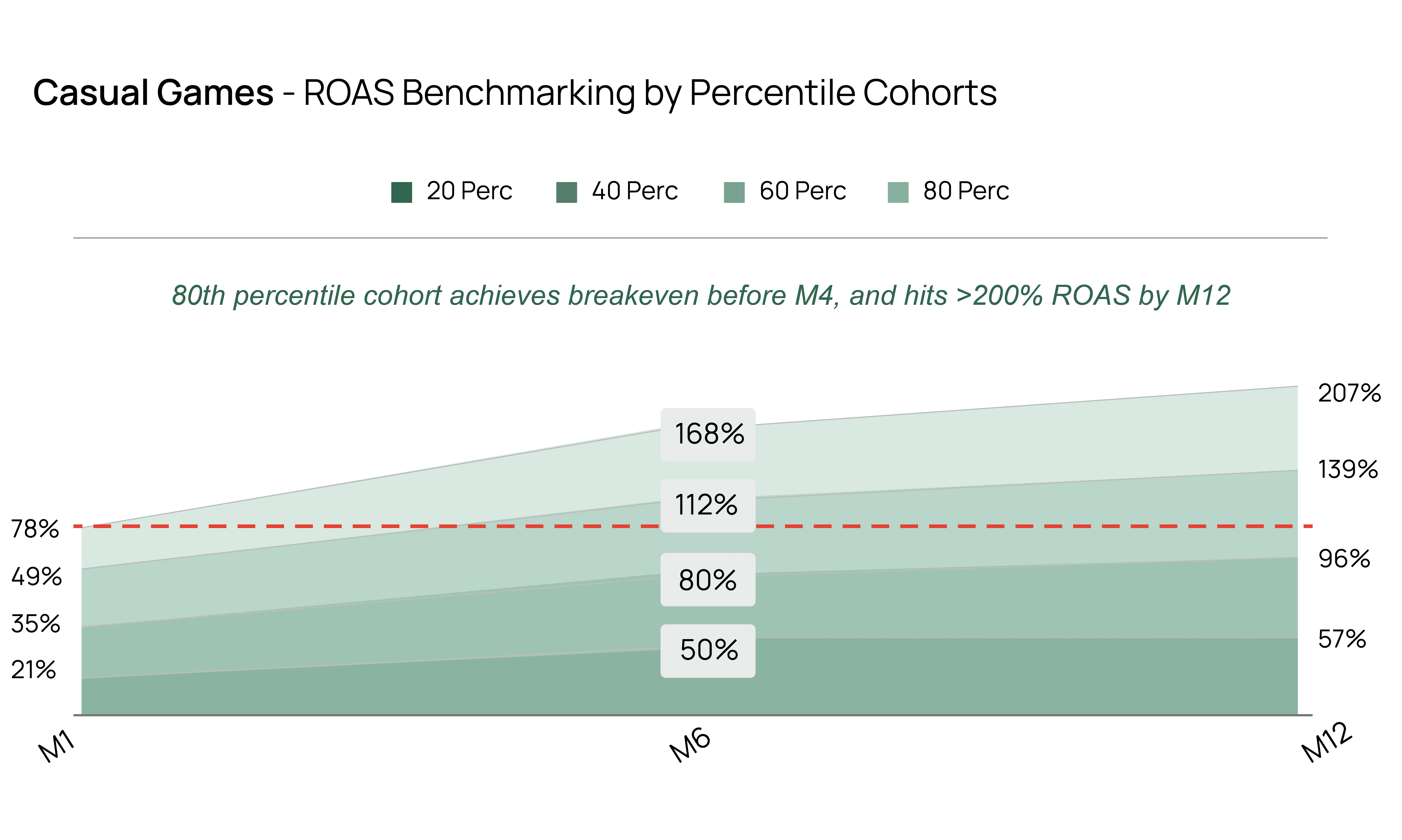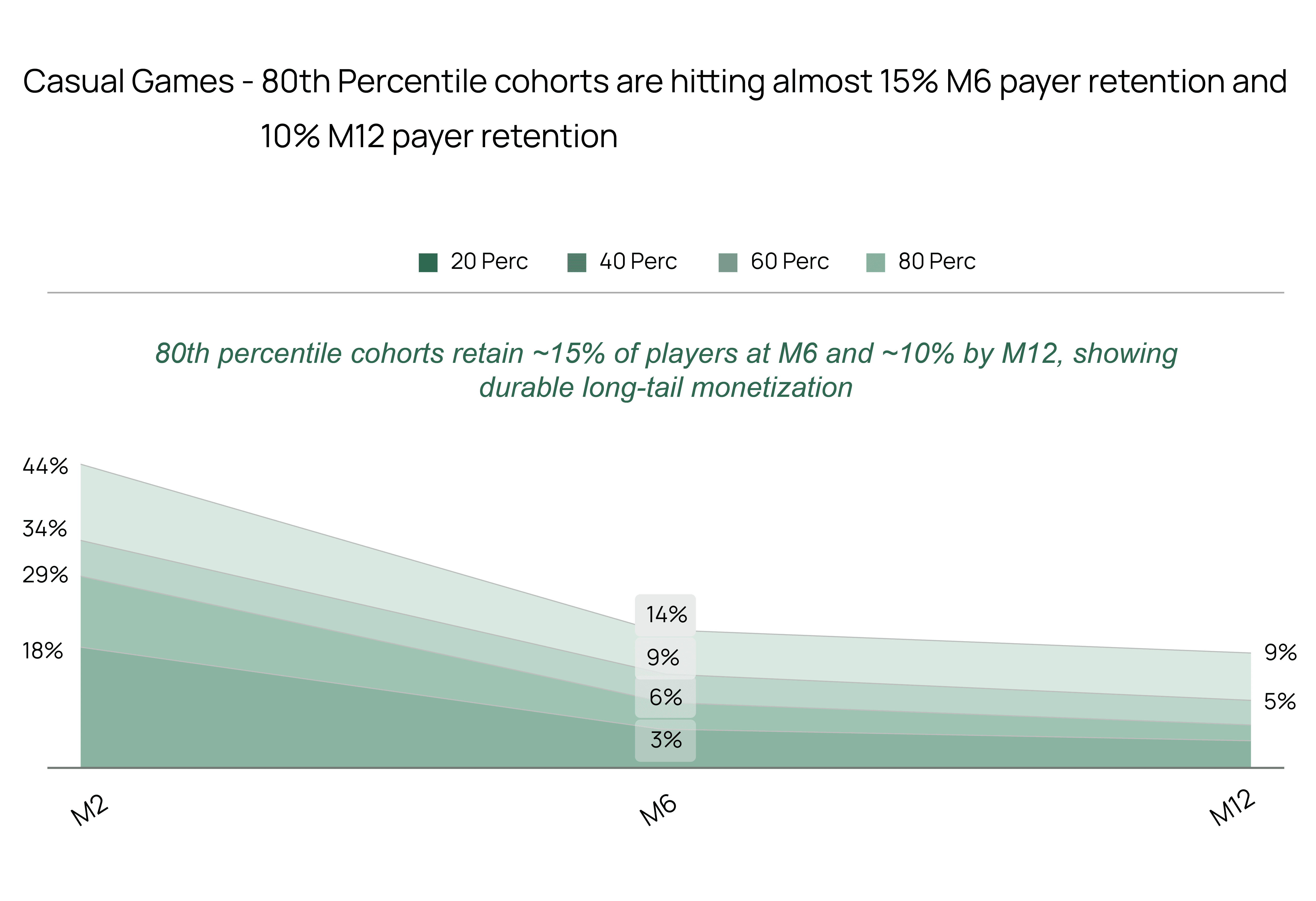In today’s high-CAC environment, understanding what makes a “good” user acquisition cohort is critical to scaling profitably. This article outlines PvX’s five-part framework for evaluating cohort quality — from payer retention to ROAS consistency — based on thousands of data points across gaming and consumer apps. Whether you’re seeking funding or optimizing UA strategy, this is the benchmark guide to know if your cohorts are truly ready to scale.
Jun 30, 2025 - 7 min read

In an era where user acquisition costs are at all-time highs and benchmarks for profitable growth are evolving faster than ever, our analysis of thousands of cohorts reveals a costly truth: many companies misinterpret when to scale, leading to tens — if not hundreds — of millions in unrecoverable CAC losses.
We’ve seen the full spectrum: subscription apps with slow burn M1 curves that quietly compound past 400% ROAS by M24, and casual games that spike early but flatline by M6. Over time, we’ve developed a framework we use internally - not just to decide who we fund, but to guide how we think about cohort quality overall.
Our proprietary benchmarks suggest that the best performing (>80th percentile) casual and core games cohorts achieve >150% net ROAS by month 12.

Too often, we hear UA teams still optimizing only for a single payback metric like D180 ROAS breakeven in isolation (you can substitute D180 with other timeframes like D30, M2, M6, even D360), and in our view this is a myopic approach that ignores the cohort’s lifetime yield.
There’s a difference between fast payback and durable return. A cohort that recoups their spends by M2 but ends at 120% ROAS is fragile. A cohort that takes 24 months to break even but goes on to deliver 300% ROAS in 5 years is a real growth engine.
We’ve funded titles where that deep tail gave teams the confidence to test new channels, push into new geos, and absorb CAC volatility. That’s margin of safety: the headroom you have to keep scaling without watching your entire unit economics collapse.
In our view, it’s one of the clearest signals of a business that’s ready for real capital.
For context, the best-in-class payer retention benchmarks are around 15% M6 payer retention, and 10% M12 payer retention across both casual and core games.We pay close attention to how well your games / apps retain payers (not just users), because this indicates the potential of maximizing your ROAS durability.

High payer retention signals product depth and monetization quality. It reduces reliance on power users and allows ROAS to compound steadily over time. On the other hand, low payer retention creates fragility. If 80% of your revenue comes from 5% of users, you’re one churn spike away from cohort collapse. That’s not to say power user dynamics can’t work — but they require deliberate support like VIP management, customized offers, customer service teams, etc.
We’ve found D14 and M6 payer retention to be especially predictive of long-term ROAS durability. If you’re holding onto 10-15% of payers at M6, this typically suggests long-lived cohorts.
Long-term monetization is a key differentiating factor between good and great games and consumer apps. Our benchmarks show that the best performing cohorts have been able to achieve >8% consistently monthly incremental ROAS beyond M6, and >5% beyond M12.
Now you've managed to retain your payers, but are you able to generate meaningful value from them in the long-term? We measure this in terms of monthly incremental ROAS post breakeven (note: incremental ROAS is the month-on-month ROAS increase for a specific cohort. If a cohort generated cumulative ROAS of 50% by M1 and then hits 75% cumulative ROAS by M2, then the incremental ROAS in M2 would be 25%). The best cohorts we have seen don’t just plateau, but instead continue generating 4-6% incremental ROAS monthly consistently beyond 100% ROAS. That’s what long monetization windows look like.
A longer monetization window leads to more robust cohorts. We see teams building monetization moments into the cohort lifecycle to achieve this - things like subscription offers, customized offer bundles, and loyalty loops. These features stretch LTV and convert what would’ve been single-purchase payers into multi-year revenue contributors.
Profitable ROAS is great. Consistently profitable ROAS is better and is a sign that the product is ready to scale
We often see teams with one or two great-looking months try to ramp up spend - only to see performance collapse the following quarter. That’s returns volatility and it’s usually a sign that something in the UA system is unsustainable like a one-off creative hit.
We prefer to see predictable curves - robust M1, M3, M6 performance that holds up across cohorts and months. These are the kinds of UA systems that you can fund with confidence. They don’t rely on one-hit campaigns or narrow targeting hacks.
Consistency over time signals product-market fit. It’s also what helps teams plan capital more accurately and avoid overspending and acquiring unprofitable cohorts. PvX Lambda is a free solution for operators that would like to forecast future returns and analyze cohort consistency in a standardized way that is widely accepted by investors.
Scalable cohorts typically demonstrate some degree of insensitivity in their ROAS performance even as spends ramp up significantly (or even a positive correlation between spends and ROAS performance).
The final test: what happens when you try to scale?
We’ve seen teams go from $300K to $600K/month in their UA spends with ROAS degradation of less than 10%. That’s scalability. Others drop 50% ROAS on the same spend ramp and can’t recover.
Strong cohort economics are necessary - but not sufficient. To scale UA, you also need:
This is where we see a shift in mindset. UA isn’t just a marketing metric - it becomes a financial asset that requires strategic allocation. How much more yield (actual incremental revenue dollars) are you generating on each incremental dollar spent on marketing? Not just on an ROAS basis, but on a time-weighted, capital-efficiency basis. The teams that scale best-in-class already think this way.
We’re seeing more pressure on UA economics - but also clearer signals of what separates the top 10%:
At PvX, we use this framework every day to assess funding opportunities, and also to help founders understand whether their growth is compounding or they are just spending inefficiently.
If your cohorts are showing depth, consistency, and tail monetization, you’re ahead of the curve and we should have a financing discussion. We’ve built PvX Capital to help companies like yours scale faster, without dilution, and with data-backed confidence.
Some of the fastest growing businesses in the industry